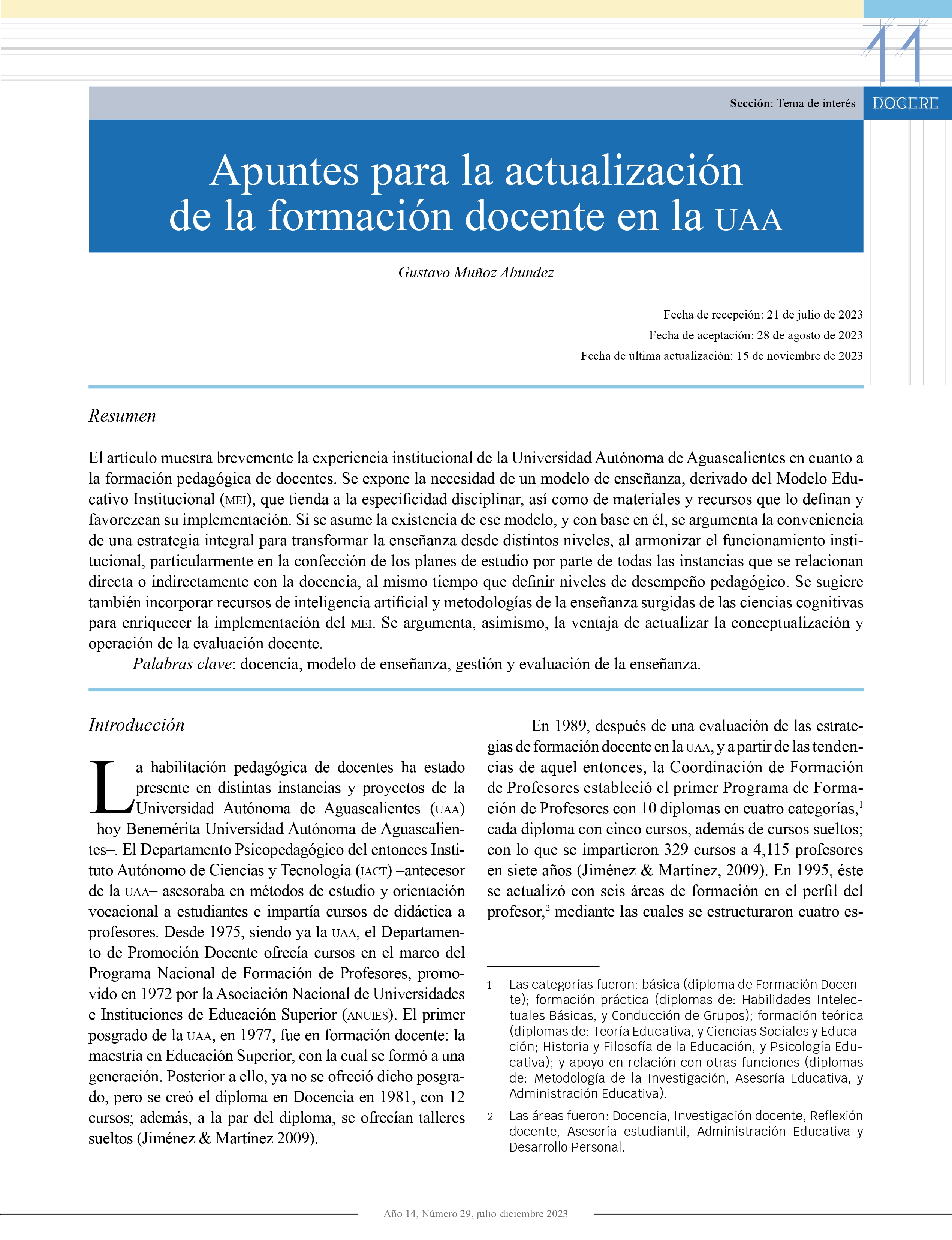Notes for Updating Teacher at UAA
DOI:
https://doi.org/10.33064/2023docere295073Keywords:
teaching, teaching model, management and evaluation of teachingAbstract
The article briefly shows the institutional experience of the Universidad Autónoma de Aguascalientes regarding the pedagogical training of teachers. The need for a teaching model, derived from the Institutional Educational Model (IEM), which tends to discipline specificity, as well as materials and resources that define it and favor its implementation. Assuming the existence of this model, and based on it, the convenience of an integral strategy to transform teaching from different levels is argued, by harmonizing institutional functioning, particularly in the preparation of study plans by all those directly or indirectly related to teaching, and at the same time defining levels of pedagogical performance. It is also suggested to incorporate artificial intelligence resources and teaching methodologies from the cognitive sciences to enrich the implementation of the MEI. Additionally, the advantage of updating the conceptualization and operation of teacher evaluation is argued.
Translated by Alexia Carolina Cruz Rodríguez.
Downloads
References
Baker, T., Smith, L. & Anissa, N. (2019). Educ-AI-tion rebooted? Exploring the future of artificial intelligence in schools and colleges. Londres: nesta. https://acortar.link/YzKBfj
Basogain, O. (s.f.). Redes neuronales artificiales y sus aplicaciones (material del curso). UPV-EHU-Escuela Superior de Ingeniería de Bilbao-Departamento de Sistemas y Automática. https://acortar.link/sOmol
Carmona, J. (2021). Ciencia cognitiva, neurociencia y educación. En D. Flores et al. (eds.), Neuroeducación, de lo científico a lo práctico (pp. 22-36). Asociación Normalista de Docentes Investigadores. https://acortar.link/nXmu00
Jiménez, M. & Martínez, J. (coords.) (2009). Testimonios docentes y la formación de profesores en la Universidad Autónoma de Aguascalientes. México: UAA. https://acortar.link/1vaETi
López, M. (2006). Relaciones entre aprendizajes implícito y explícito e inteligencia general en alumnos de enseñanza general básica (EGB). Interdisciplinaria, 23(1), 101-108. https://www.redalyc.org/pdf/180/18023106.pdf
Manghi, D. (2011). La perspectiva multimodal sobre la comunicación. Desafíos y aportes para la enseñanza en el aula. Revista Electrónica Diálogos Educativos, (22). https://dialnet.unirioja.es/servlet/articulo?codigo=3931351
Nkambou, R., Bordeau, J. & Mizoguchi, R. (eds.) (2010). Advances in intelligence tutoring systems. Canadá: Springer.
Power, I. et al. (2019). Artificial Intelligence, smart classrooms and online education in the 21st century: Implications for human development. Journal of Cases on Information Technology, 21(3). https://acortar.link/vahhm
UAA. (2016). Plan de Desarrollo Institucional 2016-2024. UAA. https://www.uaa.mx/portal/nuestra-universidad/plan-de-desarrollo/
UNESCO. (2021). Inteligencia artificial y educación. Guía para las personas a cargo de formular políticas. UNESCO. https://acortar.link/AkABWy

Downloads
Published
How to Cite
Issue
Section
License
Esta obra está bajo una Licencia Creative Commons Atribución-NoComercial-CompartirIgual 4.0 Internacional.
El lector y/o usuario que utilice el material publicado en la revista DOCERE de la Universidad Autónoma de Aguascalientes, deberá en todos los casos: a) Reconocer la autoría del material utilizado, proporcionando un enlace a la licencia, además de indicar sí se han realizado cambios al material; b) Queda prohibido utilizar el material proveniente de la revista DOCERE, con finalidad comercial y, C) En los casos en los que se realice la remezcla, transformación o creación, a partir del material publicado de la revista DOCERE, se deberá dar reconocimiento de los derechos que correspondan a la Universidad Autónoma de Aguascalientes, en su carácter de titular de la materia protegible utilizada. En caso de infracción a lo antes dispuesto, el lector y/o usuario, se hará acreedor a las sanciones que establece la legislación de la materia.












